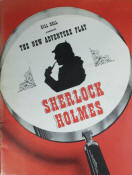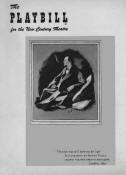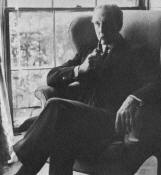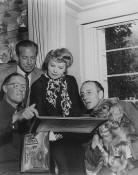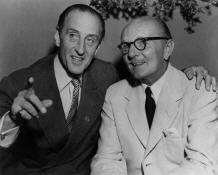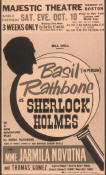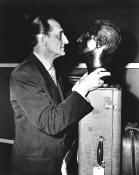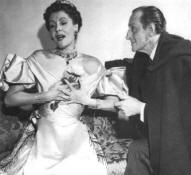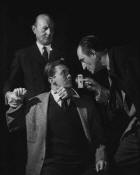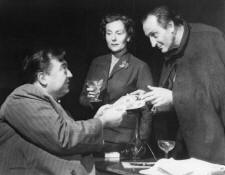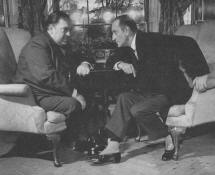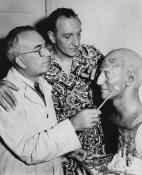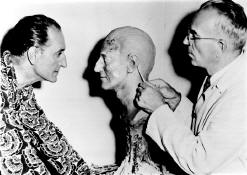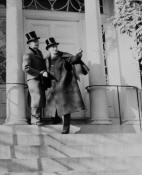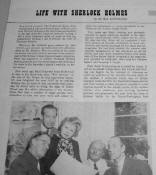Cast of characters
"Not William Gillette's famous old warhorse, but a new pastiche of Holmes material concerned chiefly with the theft of the Bruce-Partington submarine plans. After bouncing all over London, the play shifts to the Swiss chalet of Professor Moriarty, with Holmes and the professor vanishing in the locked-together death plunge from which Holmes had later, by popular demand, to be restored to life. In the present case, the plunge hardly mattered, since Holmes was scarcely alive to begin with." —Louis Kronenberger, ed., The Best Plays of 1953-54, (Dodd, Mead and Co., 1954), p. 315 Rathbone had been considering playing Sherlock Holmes on the stage as early as 1946 and wrote letters to Vincent Starrett about the possibility of Christopher Morley collaborating on a script.1 Rathbone also corresponded with Adrian Conan Doyle (son of Sir Arthur Conan Doyle, author of the Sherlock Holmes stories) about a Sherlock Holmes play. In 1951 Adrian wrote to Rathbone: "The perfect Sherlock Holmes play, a play which would present a simple task to any capable playwright, would be based on a combination of 'A Scandal in Bohemia' and 'The Adventure of the Second Stain.'"2 Eventually Basil suggested to his wife Ouida that she should write the play.3 She had some experience writing scripts and scenarios. Ouida tried to follow Adrian Conan Doyle's wishes and combined elements from 'A Scandal in Bohemia' and 'The Adventure of the Second Stain." She wrote: "In the interest of retaining as much as possible of the durable literary style of the author, I extracted every line of actual dialogue from the fifty-six Sherlock Holmes stories and four novels so that whenever possible, I could express myself in the actual words of the writer. Stories were combined, ... and gradually, the play took the form of Holmes' battle for the Bruce-Partington Submarine plans."4 Basil Rathbone was very confident in his wife's ability to write an excellent play, and he was delighted when Adrian Conan Doyle gave his approval of Ouida's draft.5 The Rathbones forged ahead raising money for the play from investors. But they ran into difficulty finding a producer. They sent copies of the play to one producer after another (Homer Curran, Freddie F. Finkelhoffe, Howard Lindsay, Gilbert Miller) and each one turned them down. Finally, in early 1953, Bill Doll, a press agent who was enthusiastic about the play, agreed to produce it.6 Stewart Chaney was hired to design the sets and costumes, and Reginald Denham was hired to direct the play. Rathbone thought the cast was wonderful. In a letter to Vincent Starrett, he wrote that Jack Raine was perfect as Watson, and Thomas Gomez was a great Moriarty. Basil also wrote, "Stewart Chaney's sets are the best he has ever done."7 Nigel Bruce was unable to audition to play Watson because he had suffered a heart attack. Bruce died on October 8, 1953, so he never had the opportunity to see this play. In response to comments and suggestions from Vincent Starrett and others, the Rathbones worked at revising the script numerous times. They were still making last-minute revisions during dress rehearsals. The first dress rehearsal in Boston was a train wreck. Rathbone wrote, "Everything went wrong, including the stage manager, who fainted at his desk from a mild heart attack."8 Due to lots of technical difficulties, including complicated lighting and cumbersome sets, the rehearsal went on until 8:00 in the morning, instead of ending at midnight as scheduled.9 Boston was selected for the premiere/tryout of the play "because it is the headquarters of the Speckled Band, one of the largest chapters of the Baker Street Irregulars, a national organization of Sherlock Holmes enthusiasts."10 Producer Bill Doll originally planned to have pre-Broadway tryouts in both Washington DC and Boston, but later press releases mentioned only the Boston premiere at the Majestic Theatre. He also planned for a European tour of the play after it ran in New York and London. One press release stated, "The new adventure play ... has already been invited to play at four European drama festivals and dates will be arranged shortly to precede or follow the show's run in London which is currently being negotiated. Present plan is for 'Sherlock Holmes to go directly from Boston for a Broadway opening during the week of November 2."11 The play opened in Boston on October 10, 1953. The Boston reviews were fairly good, calling the play "a handsome affair ... with fine dramatic surprise ... good nostalgic fun. ... The acting of the principals ... is of first-rate quality. ... The plot ... is quite serviceable."12 The Stage reported that the play was "a highly diverting item of make-believe, a pleasant evening indeed. ... The production is multi-scened, handsome and expensive. ... The theatre needs just such a full-bodied spoof as this and 'Sherlock Holmes' deserves a long and profitable run."13 Basil was encouraged by the positive reviews in Boston. In spite of opening night problems—Rathbone admitted to having premiere jitters and messing up his lines14—he believed that the play would be a success. The tryout in Boston was supposed to last three weeks, but it was doing so well in Boston that the producer cut it short by one week and moved up the Broadway premiere to October 30.15 Concerning opening a play on Broadway, S.E. Dahlinger and Glen S. Miranker wrote, "The power to decide whether any play lived or died was vested in the nine members of the New York Drama Critics' Circle. ... The combined power of these men, based on the circulation of their papers, was unprecedented in its ability to sway the theatre-going habits of the public. If they did not like the play, their combined opinions closed it."16 On opening night in New York the performance was plagued by more technical problems. Terry Kilburn, who played the part of "Billy" in The Adventures of Sherlock Holmes (1939), also appeared in Sherlock Holmes. He recalled that the lights didn't come up on his scene, so he had to play it in the dark! He also mentioned that the New Century Theatre was "a really mammoth theatre, very hard to play in, and people weren't miked in those days, so you really had to yell if you wanted to be heard."17
The next day the reviews came in. Basil wrote that the morning reviews "dug a deep grave for us. The afternoon papers shoveled us in, and in due course the magazines covered us up."18 In a review titled "Sherlock Holmes Bungles the Case at the Century," Louis Sheaffer wrote, "The only one who acquits himself with substantial credit is scene designer Stewart Chaney, who obviously had himself a picnic."19 Brooks Atkinson, of the New York Times, lamented, "Both the play and the performance lack a point of view. ... the performance is complicated, busy and lacking in style."20 Not all of the New York reviews were negative, though. One positive review appeared in the New York Daily News:
Alas, the one good review was not enough to save the production. The theatre-going public read the reviews and stayed away. Neither the handsome and elaborate sets nor Basil Rathbone himself were enough to attract the crowds. The failure of the play was a terrible shock to Basil. The audience had applauded the play and given Rathbone reason to believe it was a success, but the critics didn't like it. He wrote: "There can be no more theatre for me for a while—I must concentrate on making money to pay my debts—this I can only do in motion pictures, where fortunately it would appear I am in demand."21 In an interview for Scarlet Street magazine, Terry Kilburn said that it was a bad play. When asked why, he responded, "Well, she [Ouida] really wasn't a very good writer. Everybody can't just sit down and write a play. ... It was very sad. They had a lot of their own money in it, I believe, and they decided to produce it in a real old-fashioned way, with big sets. They thought that that would be what would appeal to an audience."22 When Adrian Conan Doyle heard about the play closing, he wrote to Ouida and Basil:
Adrian gave Basil his sympathy and assured him that the failure of the play was not his fault. So what was wrong with the play? Was it a bad play, as Terry Kilburn said? If so, why did the Boston audiences love it? The whole point of a pre-Broadway tryout is to get an idea of how the play will be received on Broadway. Producers then have a chance to work out the kinks and make last-minute changes. Yes, Sherlock Holmes had technical difficulties, but the Boston audiences loved it. One can't blame Bill Doll, Basil and others for thinking that the play would succeed on Broadway. In hindsight, we can say that they should have stayed off Broadway. Perhaps they would have found success in London.
Notes:
|
||||||||||||||||||||||||||||||||||||||||||||||||||||||||||||||||||||||||||||||||||||||||







